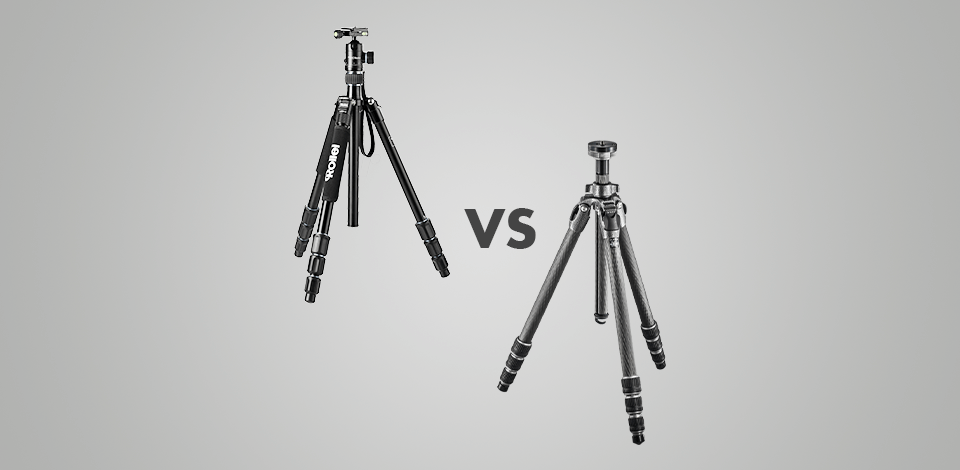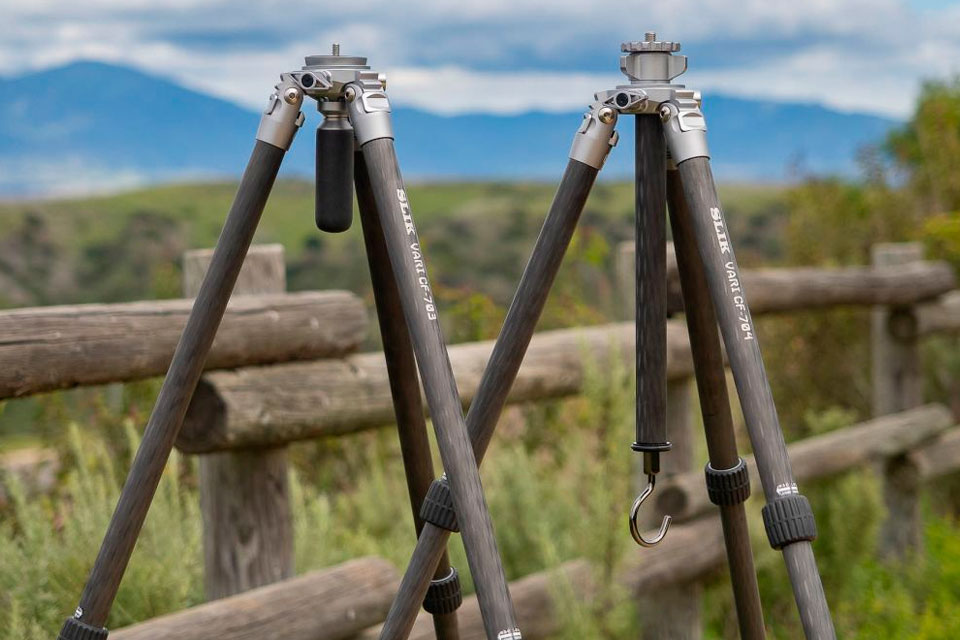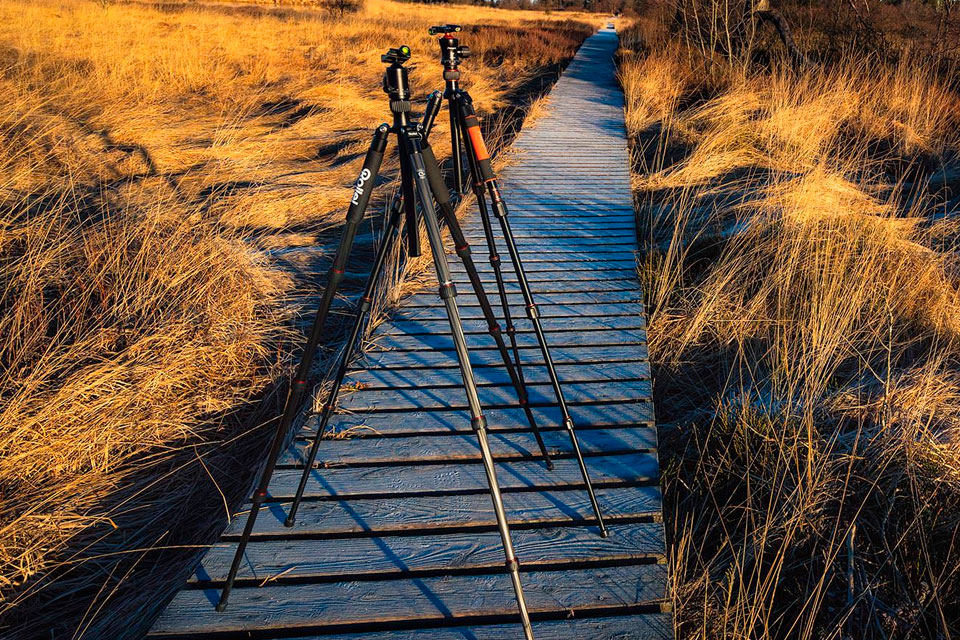
Comparing carbon fiber vs aluminum tripod models, you should primarily consider your professional needs. Choosing the first variant, you will get a stiffer, lighter, and more durable support for your gear. Besides, carbon fiber tripods transcend their aluminum counterparts with higher resistance to corrosion, scratches, and different weather impacts. Aluminum tripods brag about better stability due to their larger weight. Besides, they are more budget-friendly.
Below I have described the most important differences between these 2 types of tripods. You will learn about construction features, material & longevity dependence, size and weight, price, and more.
Carbon Fiber Tripod:
+ Lightweight, suitable for trips
+ Long-lasting design
+ You don’t need to wear gloves in winter to use it
- Too expensive for novices
Aluminum Tripod:
+ More stable and resistant to strong winds
+ Cheaper than carbon fiber tripods
+ Suitable for shooting at cold winter nights
- Heavyweight
Carbon fiber is 20-30% more expensive than aluminum even if we are evaluating entry-level models. Such a high price is justified by an advanced production mechanism. So, if you are on the hunt for tripods under $50, you should opt for aluminum tripods.
Fortunately, there is a tendency for reducing the cost of carbon fiber tripods so that even enthusiasts can purchase them. It doesn’t mean that such tripods become less durable – the range of manufacturers is growing and so does the range of products.
Carbon tripods attract photographers with better stiffness, portability, and corrosion resistance. Such characteristics are very important if you want to make a one-time investment and get a tripod that will serve you for a long time.
However, it doesn’t mean such tripods can satisfy each and every photographer. If you have a small camera, mainly take images in a studio or in good weather outdoors, or have a tight budget, you should have a closer look at an aluminum tripod.

Carbon fiber surpasses aluminum material being 40% lighter and 10 times more durable per unit of volume. Carbon fiber tripods better cope with severe shooting conditions and resist damage more efficiently. That’s why they are the No. 1 choice for outdoor and traveling photographers.
Aluminum tripods can’t boast fantastic durability but that doesn’t mean they will fall apart if you accidentally bump or drop them. The sad truth is that even top-tier aluminum tripods are subject to corrosion over time and their average service life ranges from 3 to 5 years. Carbon tripods can preserve their original state for many years in a row.
In general, aluminum is more malleable but you can continue using such tripods if you accidentally cause small damage to them. Carbon fiber is harder but it can crack and shatter in extreme conditions.
Comparing carbon fiber vs aluminum tripod in terms of durability, you should also pay attention to different components of construction. What are the internal joints? What type of leg locks did a manufacturer use? Typically, flip locks raise the cost of a tripod significantly, while a model with twist locks is likely to belong to a budgetary group. It is simple – you have to pay for security and reliability.
Of course, if you want to prolong the service life of your tripod, you need to care of it all the time. However, if you frequently shoot in challenging conditions and don’t want a tripod that can let you down in the most important moment, you should opt for a carbon fiber model from any tripod brand.
For the sake of the experiment, you may try smacking aluminum and carbon fiber tripods against a hard object or surface. Listen attentively to the sound produced and compare how they reduce vibration. An aluminum tripod will emit a loud metallic sound when reaching the surface, while a carbon fiber tripod will produce a hollow knock sound in the same situation. This is an interesting test for understanding their capacities.
Overall, carbon fiber excels at absorbing any shock or vibration, thus, guaranteeing a steadier shot. If you still prefer aluminum tripods and want to minimize shaking during a photo session, you should take advantage of a remote control. Another way to stabilize a frame is to add some weight to the feet of a tripod.

Aluminum or carbon fiber tripod – much depends on your regular shooting routine and whether you need to carry this tool for a long time on your back.
Carbon fiber tripods stand out with their small weight. Different manufacturers produce varied types of tripods but in general carbon fiber ones are 1-2 pounds lighter than aluminum analogs. This may seem insignificant but if you need to take your equipment to remove locations, you will surely feel the weight.
Though aluminum tripods weigh more, they provide better stability for a whole shooting system. Besides, they perfectly resist gusts of wind and cars passing by. If you are lucky to own a car and can transport all your gear in it, weight difference won’t be a decisive factor.

Talking about stiffness, we mainly refer to the capabilities of a tripod to minimize camera shake when pressing the release button. This factor looms large if you want to receive crisp and detailed images.
Based on the data collected by DexCraft, carbon fiber has a 5x greater stiffness-to-weight ratio than aluminum. Interpreting these numbers for photography, we can say that tripods made of carbon fiber are resistant to flexing and transmitting vibration that can further transform into camera shake. Thus, they guarantee terrific stability and sharper and clearer images.
However, manufacturers need to utilize highly technical means to create carbon fiber. Besides, not all carbon fiber types meet the established standards. There are different quality levels for this material, but, in general, carbon fiber is several times stronger than aluminum.

When you compare a tripod carbon fiber vs aluminum one, you should focus on where you usually take photos.
The thing is that aluminum tripods amplify the temperature of the surrounding you use them. For example, if you photograph on a sunny day, your aluminum tripod may become very hot, which causes lots of inconvenience. So, you need to carry gloves or something of this kind when you work outdoors.
Carbon fiber is several steps ahead of aluminum in this regard. The material doesn’t absorb warmth or cold, so you can conveniently relocate it when needed. Even if you happen to work in extreme conditions, you won’t experience problems with temperature transmission.
However, carbon fiber tripods become staggeringly fragile when placed outdoors in freezing temperatures. If you smack them against a wall, tree, stone, or anything else, they may fall apart like regular glass. So, very gentle handling in winter is a must.

Is carbon fiber lighter than aluminum? Yes, and there is direct dependence between the stability of a tripod and its weight. Thus, aluminum tripods are unrivaled in terms of camera stabilization. Aluminum tripod for heavy lenses is a perfect option because you don’t need to put anything on the feet for a motionless frame.
If you have to take images in the open air from time to time, you definitely want to have peace of mind about your camera safety. If you use a heavier tripod, you can be sure it won’t unexpectedly fall down because of stormy weather or heavy traffic.
Carbon fiber tripods are less attractive if you are concerned about the stability of your gear. Considering that cameras, lenses, and other accessories cost a lot, it is paramount to keep them safe at every moment of a photoshoot. Fortunately, some tripods made of carbon fiber have a special hook at the bottom of their base, so you can attach a heavy bag. It is difficult to find a tripod that is portable yet stable, so you need to define your priorities.
The market abounds with great aluminum and carbon fiber tripods. In fact, even the same manufacturer can offer products of both types.
If you need a tripod for travel photo shoots, check out Manfrotto tripods:
ZOMEI makes compact and lightweight tripods:
NEEWER tripods will appeal to those photographers, who need entry-level full-size models:
The unquestionable winner in this category is carbon fiber. Tripods made of this material have a small weight and size, so carrying them around won’t cause problems. Such portability doesn’t come at a cost of durability. As manufacturers state, carbon fiber is 40% lighter than aluminum while being 10 times stronger. Such construction can be called evolutionary and is much praised by both developers and users. Aluminum can be also made more rigid but such a modification will have a direct impact on the size and weight of tripods.
Comparing carbon fiber vs aluminum tripod in terms of cost we receive such a result – 88c vs $10, which means carbon fiber is more than 10 times more expensive than aluminum.
It is made of thin, amazingly strong crystalline filaments of carbon and is 5x stronger than steel and 2x than stiff.